Vol 3 No. 40 TROPIC LIGHTNING NEWS September 30, 1968
Index
25th Infantry Division Proves Mighty In 27th Year
On October 1, the Tropic Lightning Division closes the 27th chapter
of its history. It is a chapter written in combat and filled with success
after success on the battlefield and in the "other war" against sickness,
hunger and oppression.
During its writing, more than 11,000 enemy fell dead before the
25th's firepower and more than 260,000 Vietnamese received medical care from
soldiers wearing the Lightning patch.
In the history of the last year words like Tet, Soui Cut, Trang
Bang and Tay Ninh stand out in bold type. They recall battles that have
great meaning to the men of the 25th and the people of Vietnam.
The Division didn't stop to observe its anniversary last year.
Just after October 1, 1967, four men of the 3d Squadron, 4th Cavalry, stayed in
a burning tank halfway between Cu Chi and Go Da Ha to fire more than a dozen
rounds from the 90mm during a midnight battle. The CG of the Division,
Major General F.K. Mearns, said some words that those four men will remember for
a long time: "Doing something like that takes one hell of a lot of
guts."
In October, one of the largest land clearing operations of the war
began in the HoBo Woods. The 25th's 1st Brigade provided security for
the 65th Engineer Battalion and the 27th Land Clearing Team. By the time
the operation was over, the two units had leveled more than 11,000 acres of the
VC sanctuary. Along with arms and food caches, they uncovered a huge
tunnel complex that took three days and nights to go from one end to the other.
(Continued On Back Page)
The 25th Infantry Division wasn't quite ten weeks old when the
Japanese sent fighter bombers roaring through Hawaii's Kolekole Pass on the
morning of December 7, 1941, and broke the Sunday calm with machine gun fire.
It was at the same moment just 25 miles away that other enemy
planes were raining bombs and destruction over the fighting force of the
Navy's Pacific Fleet at Pearl Harbor.
Not until the following November, when the 25th left Honolulu for
its campaign on Guadalcanal was the Division able to return the favor to the
Japanese. Their mission at Guadalcanal was to break through the Japanese
flank and capture Mount Austen.
Marching 14 miles through the jungle, the Division set up its lines
as planned. Then the sky fell for the enemy as the Division barreled
through his lines and swept up the slopes of Mount Austen. Within 10 days
the enemy was bottled up in three main pockets.
As 25th Division infantrymen battled in the open and pushed through
the jungles of Mount Austen, DIVARTY pounded the mountain crest from its
position in the foothills.
The Japanese occupation of Guadalcanal was over. It was the
unprecedented speed with which the Division waged and completed this campaign
that earned it the designation "Tropic Lightning."
Valla Lavella and New Georgia followed in close succession, both
characterized by heavy fighting in jungle terrain.
Sent to train in New Zealand for the assault on the Philippines,
the Tropic Lightning Division hit the island of Luzon in December, 1944.
During the Philippine Campaign, the 25th accounted for more than 6,000 Japanese
killed in 165 days of continuous combat.
Six unit citations and six Medals of Honor were awarded to units
and men of the Division during World War II.
When the war was over, the Division moved to Japan for occupation
duty. They stayed in Japan for slightly less than five years before the next
call for combat rang out.
(Continued On Page 6)
99 Enemy Killed
Bobcats' Defense Force Enemy Retreat
DAU TIENG - Elements of the 1st Battalion (Mechanized), 5th
Infantry, repelled a human wave attack launched by an estimated enemy battalion.
Ninety-nine enemy were killed before they retreated.
Soldiers of Company A were set up at a night laager position three
miles southwest of Dau Tieng in the Ben Cui rubber plantation, scene of much
recent fighting.
At 3:45 a.m. several men using starlight scopes noticed movement
all around the perimeter. Alerting their comrades, they took their
positions and with an illumination flare as the signal, opened up on the enemy.
Caught unexpectedly, but not unprepared, the enemy launched a
thunderous mortar and rocket attack from the north side, while making a human
wave assault from the south and east sides of the perimeter.
Sergeant David Guider, 21, of Oakland, Calif., stated, "It was
raining mortars and RPGs everywhere. I've never seen anything like
it."
The infantrymen had set up anti-RPG screens before the attack.
Lieutenant Colonel Andrew H. Anderson, battalion commander of the Bobcats, said:
"The full worth of anti-RPG screens was quite evident. The cyclone fence
and engineering stakes which each track had at their positions saved countless
lives, and we didn't lose a track."
The enemy continued fighting back bitterly, taking heavy losses as
they made desperate attempts to storm the perimeter with bangalore torpedos and
home-made ladders.
With the help of spooky flareships, their own mortar crews,
artillery and gunships, the Bobcats' battle continued until 7:10 a.m. when the
enemy fled.
The battalion's Company B was air-assaulted to the area and
killed 10 of the retreating enemy.
A sweep of the battlefield revealed 99 enemy bodies and piles of
enemy ammo, bangalores, grenades and RPG rounds all of which were destroyed by
the combat engineers.
Included in the items captured were 5 RPG launchers with 42 rounds
and 14 boosters, 18 AK-47 assault rifles, and 5 CHICOM machine guns.
Also captured were 50 grenades, 3 rounds for a 57mm recoilless
rifle, 7 rounds of 60mm mortar, and a radio head set with several hundred feet
of commo wire. The Bobcats also found gas masks, web gear, plastic
explosives, and more than 2,200 rounds of small arms ammunition.
Third Platoon leader, First Lieutenant Stephen Waddell, 21, of
Madison, Wis., said: "They did a great job. They kept their heads, and
I've got nothing but praise for them. Better men I couldn't ask
for."
"This was a team effort on the part of every Bobcat. The
proof laid around their perimeter there in the Ben Cui," Colonel Anderson
said. "The Bobcats were singularly honored by our commanding general
when he sent a message saying 'First of the Fifth Mech stood tall last night;
the entire Division is proud of you.' I couldn't be prouder," the
battalion commander added.
First Bde Put Down VC Move
TAY NINH - Soldiers of the 1st Brigade fought off a major attack
near the Dau Tieng base camp as enemy activity around Dau Tieng and Tay Ninh
increased.
More than 100 enemy soldiers were killed in 14 hours of fighting
around the U.S. bases.
Ninety-nine enemy soldiers, dressed in green NVA uniforms and
carrying relatively new weapons, were killed in an abortive attack on a night
defensive position of Company A, 1st Battalion (Mechanized), 5th Infantry, three
miles southwest of the Dau Tieng base camp in the Ben Cui rubber plantation.
A relief force from Company C of the Bobcats came under heavy fire
from an enemy blocking force half way to Alpha's position.
Company B, located in the Dau Tieng base camp was helilifted to the
south of the fight to pinch the enemy off. However, the enemy broke contact and
fled shortly after their arrival.
The enemy also made his presence known around Tay Ninh, shelling
U.S. fire support bases and the 1st Brigade's Tay Ninh base camp.
Hardest hit was Fire Support Base Buell II, two miles north of Tay Ninh City.
The base received an estimated 200 mortars and RPG rounds.
(Continued on Back Page)
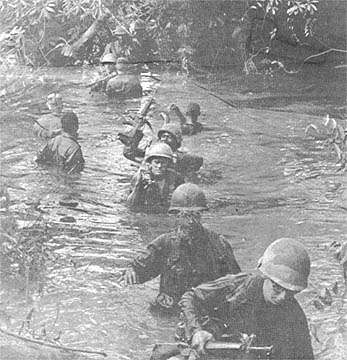 |
ONE MORE RIVER - The endless number of rivers, canals and rice paddies make the going rough and wet for this squad from Company D, 1st Battalion, 27th Infantry Wolfhounds. (PHOTO BY SGT ROSS ROESSLER) |
Page 2 TROPIC LIGHTNING NEWS September 30, 1968
Decorated
| DISTINGUISHED SERVICE MEDAL | |
| MG Ellis W. Williamson | |
|
AIR MEDAL (HEROISM) |
|
|
LTC King Coffman, HHC, 2d Bn, 22d Inf WO1 Peter S. Webb, D Trp, 3d Sqdn, 4th Cav W02 George A. Grinnell, Co B, 25th Avn Bn SP5 George R. Humphrey, Co A, 25th Avn Bn SP5 Ronald D. Ritchey, Co B, 25th Avn Bn SP5 Bruce K. Glenn, Co B, 25th Avn Bn SP5 Earl J. Schmuck, Co B, 25th Avn Bn |
SP4 Leo E. Baros, Co A, 25th Avn Bn SP4 Phillip E. Clark, Co A, 25th Avn Bn SP4 Dennis W. Kuchar, Co A, 25th Avn Bn SP4 Robert W. Anderson, Co B, 25th Avn Bn SP4 Jack E. Mosley, Co B, 25th Avn Bn SP4 Bobby G. McCormick, Co A, 25th Avn Bn |
|
BRONZE STAR MEDAL (HEROISM) |
|
|
COL Gordon Sumner, Jr., HHB, 25th Inf Div Arty MAJ Carrell M. Barrow, Co A, 25th Avn Bn CPT Carl N. Gilbert, HHC, 1st Bn, 5th Inf 1LT James H. Kennedy, Co A, 2d Bn, 22d Inf SSG Peter F.D. Fear, Co A, 1st Bn, 27th Inf SSG Clinton France, Co A, 2d Bn, 22d Inf SSG Ronald W. Falkosky, Co A, 2d Bn, 22d Inf SGT Kevin M. Ryan, HHC, 3d Bn, 22d Inf SGT Francis X. Mc Gann, Co A, 3d Bn, 22d Inf SGT Albino P. Lopez, Co A, 4th Bn, 9th Inf SGT Dennis C. Seitz, Co A, 2d Bn, 27th Inf SGT Robert L. Stone, Co F, 50th Inf (LRP) SGT James E. Boggess, HHC, 3d Bn, 22d Inf SP5 Bruce Williams, Co A, 65th Engr Bn |
SP5 Jerald E. Dunken, HHC, 65th Engr Bn SP5 Carl D. Mtrey, Co C, 2d Bn, 22d Inf SP5 Warren L. Vance, Co C, 2d Bn, 22d Inf SP4 David S. Van Galder, Co B, 2d Bn, 22d Inf SP4 Clay R. Atchison, Co B, 2d Bn, 12th Inf SP4 Paul R. Bloemer, Co A, 2d Bn, 22d Inf SP4 Robert A. Langford, Co A, 2d Bn, 22d Inf SP4 John Connors, Co C, 2d Bn, 22d Inf SP4 Lionel B. Harvey, Jr., Co A, 2d Bn, 27th Inf SP4 Dennis R. St Andre, Co A, 2d Bn, 27th Inf SP4 Estevan Alvarado, Jr., A Trp, 3d Sqdn, 4th Cav SP4 Joseph M. Miller, Co A, 2d En, 27th Inf SP4 Charles R. Paige, Jr., Co A, 65th Engr Bn PFC Guy Hinton, Co A, 2d Bn, 27th Inf |
|
BRONZE STAR MEDAL |
|
|
CPT Robert J. Kelly, HHC, 2d Bn, 34th Armor CPT Earnest L. Newton, Co B, 25th Avn Bn CPT Elvin C. Scott, HHC 1LT Lewis Anderson, Jr., HHC 1LT Alfred R. Crosswell, HHB, 2d Bn, 77th Arty 1LT Loren L. Goetzke, HHC, 3d Bde 1LT Patrick G. Jordan, Co D, 2d Bn, 34th Armor 1LT Lawrence A. Loughlin, Co E, 65th Engr Bn 1LT Edgar S. Mc Kee, HHC, 1st Bn (Mech), 5th Inf 1LT Richard A. Silva, Co B, 725th Maint Bn SFC George A. Inouye, Hq & Co A, 725th Maint Bn SSG Ambrose C. Carl, HHD, 125th Sig Bn SGT Roberto Alanis, Co A, 3d Bn, 22d Inf SGT James L. Chapman, Co A, 2d Bn, 14th Inf |
SGT Willie J. Cobb, Co A, 2d Bn, 14th Inf SGT Richard Jacobson, Co A, 3d Bn, 22d Inf SGT Harold L. O'Brien, Co D, 1st Bn, 27th Inf SGT Raymond F. Scheider, Co A, 3d Bn, 22d Inf SGT Larry W. Turner, Co C, 4th Bn (Mech), 23d Inf SGT Charles D. Williams, Co C, 1st Bn, 27th Inf SGT Michael G. Wolfe, Co B, 1st Bn, 27th Inf SP5 Charles D. Dominy Jr., 25th Admin Co SP5 Eugene C. Wallis, HHC SP4 Garnet La Fountain, HHC, 1st Bn, 27th Inf SP4 Michael Belkin, HHD, 25th Avn Bn SP4 Jerry A. Bramer, Co A, 2d Bn (Mech), 22d Inf SP4 Peter R. Cardinal, HHD, 125th Sig Bn SP4 Tommie Coleman, HHC & Band, Div Spt Cmd |
|
ARMY COMMENDATION MEDAL (HEROISM) |
|
|
MAJ Forrest J. French, HHC, 2d Bn, 14th Inf CPT Wilmer A. Arroyo, HHC, 3d Bn, 22d Inf CPT Franklin D. Shiplett, HHC, 4th Bn, 23d Inf 1LT Michael S. Root, Co A, 3d Bn, 22d Inf 1LT Dorothle J. Gillespie, Co D, 2d Bn, 14th Inf 1LT Wayne L. France, HHC, 3d Bn, 22d Inf 1LT Kelly Albrecht, Co B, 2d Bn, 14th Inf SGT Kurtis M. Boyter, HHC, 3d Bn, 22d Inf SP5 Kenneth H. Brunelle, HHC, 4th Bn, 9th Inf |
SP5 Johnnie L. Jones Jr., D Trp, 3d Sqdn, 4th Cav SP4 Terry B. Weigold, Co D, 2d Bn, 12th Inf SP4 Richard H. Knorowski, Co B, 2d Bn, 22d Inf SP4 Thomas J. Bruffy, HHC, 3d Bn, 22d Inf SP4 William A. Devlin, D Trp, 3d Sgdn, 4th Cav SP4 Michael M. Old, Co D, 2d Bn, 12th Inf PFC Collier G. Harris, HHC, 3d Bn, 22d Inf PFC Charles E. Romans, HHC, 2d Bn, 22d Inf PFC Steven W. Norris, Co D, 4th Bn, 9th Inf |
Security Is Your Job
Despite the sophisticated and futuristic devices used by both the
"good guys" and the "bad guys" in present-day spy movies, books and
television shows for gathering intelligence, one of the oldest and most
effective methods of picking up military information is still to eavesdrop on
military personnel in their everyday conversation.
Science and technology have developed electronic detectors,
long-range microphones, bugging devices and anti-bugging devices. But the
one thing that can't be changed or completely controlled is the human element
- the unknowing or inadvertent disclosure of a piece of vital classified
information by an individual during the course of a conversation.
It's this one slip that just might give our enemies a vital piece
to the intelligence jigsaw puzzle they are trying to put together.
Certainly a great deal can be learned by our enemies by simply reading the newspapers, news magazines, government
publications and the like. Often we read about an operation or piece of
equipment in the news media that is supposedly classified.
Stop and think for a moment though. Is the complete story
really there, published for all to read, or have one or two vital pieces been
left out - pieces that you might know about because you work with that item of
equipment or on the particular operation?
Those are the pieces the enemy is looking for and can afford to
sift through a lot of useless or duplicated information to find. One slip
on your part may not give them all they want, but combined with the careless
slips of many others, it can help provide the pieces to an intelligence jigsaw
puzzle fatal to our country.
Security of information is not to be taken lightly. Our
enemies have sworn to bury us and our way of life and they will use every
sneaky, dirty, devious trick in the book to do it. Highly technical or
classified information should not be the subject of casual conversation.
Don't try to use your knowledge of classified matters to impress people and
don't get careless in your conversation. Somebody is probably listening
to you - possibly the wrong people. (AFPS)
Right to Vote Is Our Right To Freedom
Secretary of Defense Clark Clifford has sent the following message
to all Armed Forces Personnel:
No one needs to tell you - the men and women of our Armed Forces -
about Freedom. It is true that freedom is everyone's job. But it
is yours, especially.
In the end, that is why you wear the uniform-to protect freedom.
Freedom is the sinew of our society. It holds our nation together.
But like all muscle tissue, it has to be exercised to remain
healthy and strong.
In November of this year, we are going to hold our national
elections. They are a vital exercise of freedom. And it would be a
tragic irony if you -men and women in uniform who are ready to fight, and if
necessary even to give your lives in defense of freedom - failed to perform the
one most important act to exercise that freedom.
It is essential that every American vote. You especially.
See your voting assistance officer. He has the necessary
forms to help you cast your ballot - no matter where you are serving in the
world.
This year, September 20 has been designated Armed Forces Voters'
Day. By that date you should have your application for obtaining your
voter's ballot.
Tropic Lightning
Combat Honor Roll
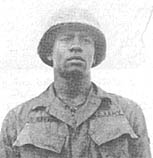 This week's Tropic Lightning Honor Roll focuses on Specialist 4
Lester Brown, 25th Medical Battalion, as the soldier whose actions best
illustrate the spirit of the American fighting man.
This week's Tropic Lightning Honor Roll focuses on Specialist 4
Lester Brown, 25th Medical Battalion, as the soldier whose actions best
illustrate the spirit of the American fighting man.
Specialist 4 Brown distinguished himself by heroic actions while
serving as a medic with Headquarters and Headquarters Company, 2d Battalion,
27th Infantry in the Republic of Vietnam.
While established in an ambush site, Specialist Brown's unit came
under an intense enemy attack, suffering numerous casualties. During the
ensuing battle, Specialist Brown, with complete disregard for his own safety,
exposed himself to a heavy volume of hostile fire as he administered first aid
to his wounded comrades.
When his medical supplies were exhausted, Specialist Brown crawled
through the devastating enemy fire back to his base camp's perimeter where he
gathered needed medical supplies and organized a rescue element. He then
led two armored personnel carriers to the beleaguered patrol's location,
loaded the wounded aboard the vehicles and returned them to the base camp.
Upon arrival, Specialist Brown continued to administer first aid
and, on one occasion, revived a comrade after administering artificial
respiration for almost one hour. His valorous actions undoubtedly saved
the lives of fourteen men.
Specialist Brown's personal bravery, aggressiveness, and devotion
to duty are in keeping with the highest traditions of the military service and
reflect great credit upon himself, his unit, the 25th Infantry Division, and the
United States Army.
The TROPIC LIGHTNING NEWS is an authorized publication of the 25th
Infantry Division. It is published weekly for all division units in the Republic of
Vietnam by the Information Office, 25th Infantry Division, APO San Francisco
96225. Army News Features, Army Photo Features, Armed Forces Press Service and Armed
Forces News Bureau material are used. Views and opinions expressed are not necessarily
those of the Department of the Army. Printed in Tokyo, Japan, by Pacific Stars and
Stripes.
MG Ellis W. Williamson . . . . Commanding General
MAJ Andrew J. Sullivan . . . Information Officer
2LT Don A. Eriksson . . . . . . Officer-in-Charge
SP4 Bill Berger . . . . . . . . . . . Editor
Page 3 TROPIC LIGHTNING NEWS September 30, 1968
Routine Mission Turns Out To Be Headache
By SP4 Tom Quinn
CU CHI - It was to be a routine mission. The Company A, 25th
Aviation Battalion, Huey took off from the Blaster pad at Cu Chi at 8:30 in the
evening.
Warrant Officer Randy Juge of New Orleans, La., the aircraft
commander, and First Lieutenant John Lebansky of Glen Cove, N.Y., the pilot, has
been diverted from a counter-mortar mission to pick up three detainees held by a
25th Division infantry unit seven miles northwest of Duc Hoa.
As the helicopter approached the location, Juge - nicknamed Cage by
his cohorts - flipped on the radio to one of the frequencies designated to
contact the infantry unit. On the one frequency he could hear only the
chatter of Vietnamese voices. He flipped on the other frequency.
Upon making radio contact Cage was requested to land from east to
west. The strobe light which would direct him in would come from a dike on
a rice paddy and the copter should land to the right and bottom of the light.
There was a tree line further to the right so Cage should be careful.
Cage lowered the craft to 100 feet and then turned on his search
light to scan the landing zone. Below, through the haze, he could see the
soldier with the strobe light lying on a dike trying to conceal himself in the
foliage as much as possible. To the left, Cage spotted other soldiers
lying scattered along a road.
Cage turned off the light and brought the craft down, turning the
light on for the last 20 feet. The Huey landed at the predetermined spot and a soldier
brought over one detainee. The MP aboard helped him in. The detainee
threw himself onto the floor and covered his head, knowing perhaps what was to
come.
As Cage waited for the other two detainees to be put aboard all
hell broke loose. From seemingly all directions, mortars flew, RPG's cut
through the air and small arms fire cracked in the night.
It seemed evident that the Viet Cong had been waiting patiently for
the helicopter to land and now they concentrated all their firepower on it.
Cage hesitated to take off thinking the other two detainees were to
be put aboard. The doorgunners' fingers twitched on their triggers but
without permission from the aircraft commander they could not fire. To
open fire was out of the question since the American positions were not known.
Cage waited no longer. He pulled pitch and took off.
When he got about 20 feet off the ground an armor-piercing AK-47 round cut into
the right side of the copter by the cockpit pillar passing six inches behind the
head of Lebansky and tearing into Cage's helmet, grazing his forehead and then
exiting out the left door.
The impact of the bullet ripped Cage's helmet off, shattered his
visor and thrust the upper part of his body violently to the left and down onto
the control panel, ramming his chest into the cyclic stick.
It was hard to imagine that the bullet had such force. But as
Cage would later recall, "It felt like I was hit with a brick."
For a terrifying moment, control of the ship was lost as the copter
dipped back toward the ground.
In these frenzied seconds Lebansky might well have taken over
control of the craft. However, since Cage's helmet had been knocked off
he was unable to communicate with Lebansky and the pall of darkness and din of
battle prevented Lebansky from quickly noticing Cage's plight.
Besides, there was nothing unusual about the way the helicopter
dipped; often this is done to gain air speed.
As the volley of fire continued to be concentrated on the ship,
Cage struggled to regain his senses. He had lost control of his craft at
its weakest moment. When a helicopter goes out of control from 10 to 100
feet, it has very little airspeed and usually goes into what pilots call the
"deadman's drop." The helicopter would almost assuredly slam into
the ground, tumble over and burst into flame.
Groping for his helmet and fumbling for the cyclic stick at the
same time, Cage finally got hold of the cyclic and pulled it back. The
helicopter streaked into the safety of the sky.
At 800 feet Cage put his helmet back on and told Lebansky to take
over the controls. Cage then radioed ahead and explained the situation.
While heading back for Cu Chi, Cage was still somewhat dazed and
disoriented. He didn't know for sure how badly he had been hurt.
But, he realized he had been lucky.
He thought how when the bullet struck he had been sitting back in
his seat while usually he piloted his ship, like many other pilots, by leaning
over like a jockey. In such a position he would have been hit dead center
in the head.
Coming into Cu Chi, Cage had planned to drop off at the 25th
Medical Battalion. But as the copter came over the 12th Evac Hospital's
pad, Cage, seeing the big red cross, told the pilot, "Put her down here."
Cage walked into the emergency entrance of the hospital and,
spotting two doctors and a nurse, asked if anyone had a band-aid. He told
them that a bullet had gone through his helmet and creased his forehead.
But nobody seemed to take him seriously until one of the doorgunners walked in
with the helmet. Then as Cage remembers it, "Their jaws dropped."
After his wound was cleaned and he was given a tetanus shot, Cage
scurried back to the pad and hopped into his helicopter. He took over the
controls, doing the job he liked best.
That night, he signed the mission sheet off as an average
counter-mortar mission.
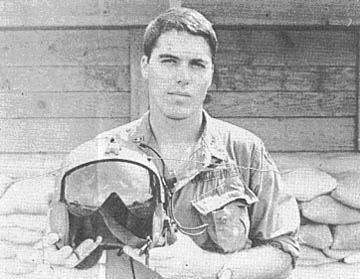 |
CLOSE CALL - Warrant Officer Randy Juge of New Orleans, La., holds the helmet he was wearing when an AK-47 round slammed through it. The wire traces the bullet's path. (PHOTO BY SP4 TOM QUINN) |
Page 4-5 TROPIC LIGHTNING NEWS September 30, 1968
Tropic Lightning Division Celebrates
27 Years of Valiant Service
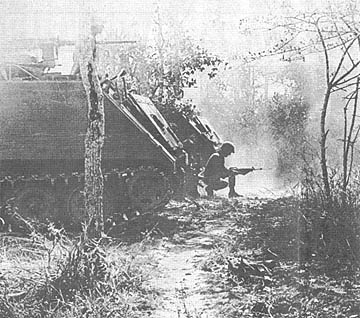 |
A MECHANIZED UNIT WAITS ON LINE |
| AN ENEMY STRONGHOLD IS ASSAULTED NEAR DAU TIENG | 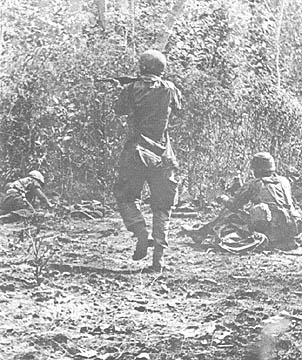 |
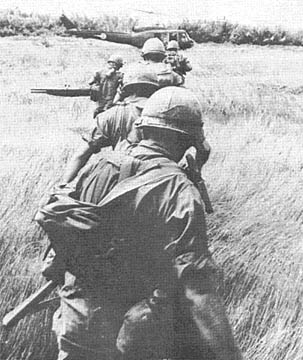 |
INFANTRYMEN HEAD BACK AFTER A SWEEP |
| TROPIC LIGHTNING TROOPERS ADVANCE UNDER FIRE | 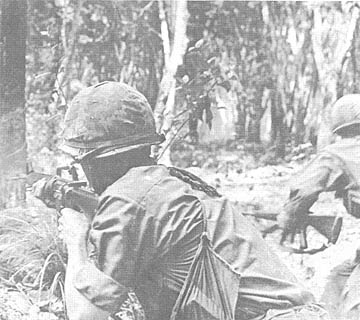 |
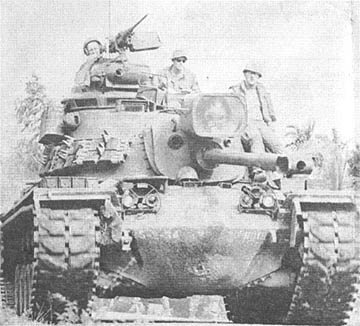 |
TANK RUMBLES THROUGH TAY NINH CITY |
| AN EAGLE FLIGHT BRINGS IN THE TROOPS |
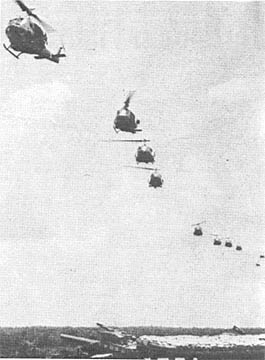 |
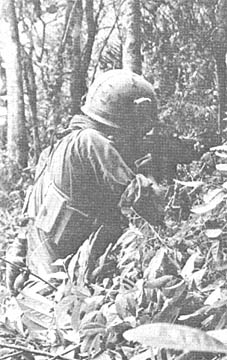 |
RIFLEMAN FIRES AT ENEMY |
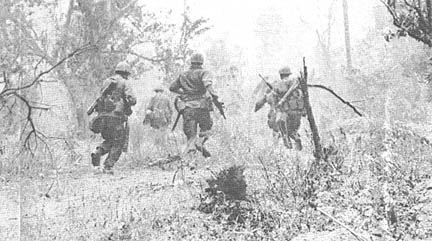 |
|
INFANTRYMEN FLANK A VIET CONG POSITION |
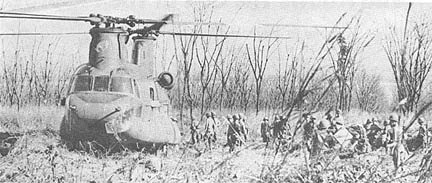 |
|
A CHINOOK RESUPPLIES THE INFANTRY IN THE FIELD |
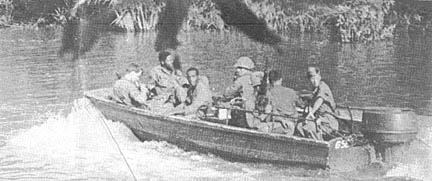 |
|
ENGINEERS TAKE INFANTRYMEN ON PATROL |
Page 6 TROPIC LIGHTNING NEWS September 30, 1968
Freedom Fighting Troopers Keep Marching On...
(Continued From Page 1)
On July 5, 1950, the directive came - the 25th was ordered into
combat. Two days later elements of the Division began arriving in Korea.
The Red columns were advancing steadily, meeting little resistance
from the outnumbered, overwhelmed Republic of Korea troops. At this point
the entire northern part of South Korea was in Communist hands.
The 25th Division was first assigned to the Sangju sector to hold
off the Communist advance. Then word came that another large Red force was
moving on Pusan from the west. Tropic Lightning was ordered to move to the
Chinju-Masan area 150 miles away to meet the oncoming force.
The Reds at Sangju, who were fighting an entire division only one
day before, feared a trap and refused to move forward. And, surprised Red
commanders near Masan, expecting to move in on Pusan unopposed, were suddenly
confronted with one of America's fightingest Divisions.
Military experts agree that this swift action and the follow-up move
into Masan were keys to saving Korea from total Red domination.
During the United Nations Counteroffensive, the Tropic Lightning
Division slew more than 8,000 enemy troops in one day.
Throughout the Korean War, the 25th fought in 10 campaigns.
Members of the Division were awarded 13 Medals of Honor, five of them to the
27th Infantry - the most decorated regiment in the Korean War.
After the Korean truce was signed, the Division stayed as an
occupation force. In September, 1954, after more than 12 years' absence,
the 25th returned to Hawaii.
Helicopter door gunners were the first men from the 25th to head
for combat in South Vietnam. The U.S. Military Assistance Command, Vietnam
(MACV) requested 100 door gunners in 1963 to relieve overworked gunners already
operating there.
In August 1965, Company C, 65th Engineer Battalion, arrived at Cam
Ranh Bay to assist in the buildup of facilities.
Four months later the entire 3d Brigade of the Division was
airlifted from Hawaii to the Central Highlands of Vietnam at Pleiku. At the same
time, the Division's 2d Brigade left by sea for Vung Tau. By the end of
January the 2d Brigade was firmly situated in the middle of a peanut patch at Cu
Chi. Viet Cong would no longer dance victoriously down the streets of Cu
Chi or in the church at Bac Ha.
In April of 1966, the Division's 1st Brigade arrived, completing
the move for "Hawaii's Own."
From January 1966 to October 1967, Tropic Lightning
infantrymen routed the Viet Cong from his once unchallenged sanctuaries.
There were huge operations like Junction City with more than 23,000 American
soldiers and Attleboro, the first slash into the center of War Zone C.
Equally important was the 25th's efforts to win the hearts and
minds of the Vietnamese people. By October, 1967, more than 140,000
Vietnamese had been treated in MEDCAPs. Thousands of bars of soap were
distributed along with boxes of clothes.
Specific names and battles stand out. At Fire Support Base
Gold in March, 1967, a four-hour battle left 647 Viet Cong dead on the
battlefield. Operation Manhattan netted more than 200,000 rounds of small
arms ammunition. One operation in the Iron Triangle accounted for more
than seven million pounds of rice.
The Tropic Lightning Division is leaving its indelible mark in
Vietnam. When this war is over the Vietnamese people in III Corps will
long remember the taro leaf with the lightning bolt in the center. It will be remembered for the care
given to the people in MEDCAPs, the help in building homes, bridges and roads;
and the compassion between an oppressed people and the soldiers who answered
their call for help.
The 25th Infantry Division will be remembered for helping to win
freedom for the people of Vietnam.
22 ARVNs Share Our Bread & Salt
CU CHI - At first glance the soldier looked like any other American
GI of oriental ancestry. He pulled KP, took his turn on the bunker line
and went on patrol.
"It never occurred to me that he might be anything but a U.S.
soldier," declared one 25th Division sergeant, "until one day I asked a
friend who he was and discovered that he was a Vietnamese soldier assigned to
the unit."
Under a program which was started in October, 1967, by the
division's former chief of staff, Colonel Jasper J. Wilson, 22 Army of the
Republic of Vietnam (ARVN) soldiers were sent from Vietnamese training centers
and assigned to units of the U.S. 25th Infantry Division.
The Vietnamese soldiers assigned to the units are all privates and
PFC's. They do everything that the American soldier of equivalent rank
does and they are also given the same privileges as their American counterpart.
ARVN soldiers assigned to the Division are sent to the five-day
replacement training course given to all newcomers. Then they are assigned
to a unit as a reconnaissance scout observer or as a rifleman with the recon
element.
Although there is sometimes a slight language barrier when the
Vietnamese soldiers are first assigned to the 25th, both they and the American
GI soon pick up a working knowledge of each other's language.
Of the original 22 Vietnamese assigned to units of the 25th, one
has been sent to the Vietnamese Officer Candidate School and two have been
wounded in action.
The story of one of the soldiers wounded is an example of the
dedication that these men show while performing their duties. Private
Nguyen Van Thanh was assigned to the Recon Platoon of the 2d Battalion
(Mechanized), 22d Infantry. Thanh's unit was sweeping the main supply
route from Dau Tieng to Tay Ninh, when they came under enemy fire.
In the initial burst, Thanh was shot through the wrist and taken to
the platoon medic bleeding profusely. When the medic turned his back to
get a dressing, Thanh grabbed his rifle and ran back to the fight. By the
time the medic caught up to him, Thanh was on the verge of passing out from loss
of blood.
Thanh's story was not an isolated case. Reports from
commanders who have ARVN soldiers assigned to their command indicate that the
Vietnamese soldiers perform their assigned tasks exceptionally well.
"These men have lived here all their lives," said one
commander. "They know the terrain and the enemy and impart this
knowledge to the American soldiers. They help us as much with this
knowledge as we help them with our knowledge of tactics."
Road Checks Filter Out VC
CU CHI - Using roadside checkpoints to detect the enemy is a method
that has been used with considerable success by Vietnamese National Police in
their efforts to stop Viet Cong and NVA infiltration into the capital city area.
Daily, National Police working with soldiers from the 2d Brigade,
establish checkpoints along major roads entering Saigon from the north.
One such check point is at the Hoc Mon bridge 10 miles from Saigon.
In the past, enemy soldiers, weapons, munitions and equipment have
been transported over this bridge and into the capital.
The amount of enemy supplies crossing the bridge has greatly
decreased in recent months due to the close inspection of each civilian vehicle
at the several checkpoints.
National Police and Tropic Lightning soldiers make up a thorough
search team. The Vietnamese police are able to search inside vehicles
where American soldiers are forbidden by the Geneva Convention.
The 2d Brigade troopers regulate the flow, allowing only one-way
traffic.
Since the inception of the checkpoint system, hundreds of suspected
infiltrators have been detained and valuable information has been obtained.
The National Police are very successful in the discovery of the
enemy and his equipment because they know the people and can sense when
something is out of the ordinary.
Infiltrators traveling south usually carry forged identification
papers. Enemy supplies are transported by carefully concealing them on
trucks, carts, buses and private cars.
Page 7 TROPIC LIGHTNING NEWS September 30, 1968
Division Mobile Training Team Aids ARVNs
CU CHI-A mobile training team from the helping forces of the ARVN
25th Infantry Division become more proficient with American arms and tactics in
a program that is widely acclaimed by American and Vietnamese officials.
The 19-man team, composed of combat veterans of the 2d Battalion,
34th Armor, is now training the 4th Battalion of the ARVN's 50th Regiment in a
continuing program expected to last many months.
The team trains the Vietnamese soldiers in the use of American
weapons, especially the 60mm mortar and the recently issued M-16 rifle and M-60
machine gun.
"When we first started we ran into a problem regarding
their 57mm recoilless rifle," stated Captain Richard E. Lovisone, the team
commander. "The U. S. forces no longer use the 57mm rifle, and we had no
one that was experienced with the weapon. We found the old technical
manuals and taught ourselves," Lovisone said.
The men of the training team can now effectively teach the
Vietnamese soldiers how to load, fire, disassemble, and clean the 57mm
recoilless rifle.
Other subjects taught by the team include squad and platoon
tactics, road clearing and mine detection, combat in built up areas, and river
crossing.
One of the favorite subjects deals with the U.S. Army's "quick
kill" method of teaching a soldier to react quickly and accurately to a moving
target.
A short lecture on the technique is given, and a demonstration is
performed in front of the class. The rest of the period is devoted to
actual practice by the students.
Employing BB guns the class practices on empty cans in small
groups. As each group finishes with the BB guns, they move on to a
live-fire range. Here, the skills are put to practical use as a line of
six ARVN soldiers move through a rice paddy firing on simulated Viet Cong.
"The ARVN soldier is basically similar to his American
counterpart," stated Lovisone. "He learns fast and is an eager
pupil."
"This program is actually a two-way street for my men," he
said. "We teach them a lot, but in return they teach us some tricks too.
For example, the ARVN is very good at searching; they seem to know exactly where
to go and what to look for."
A marked improvement is evident in the units that have already
received the training course, but it will be the long-range results that prove
the effectiveness of the program.
However, an indication of success came when two ARVN battalions not
originally scheduled to receive the training asked the Americans to give them
the 28-day course.
|
Story and Photos by R.A. Patterson |
| COMBAT FIRE - First Lieutenant Duncan Green of Tarrytown, N.Y., points to a series of targets while sweeping through a rice paddy with a group of Vietnamese infantrymen during the combat fire class. The ARVN soldiers are using newly-issued US M-16 rifles. | 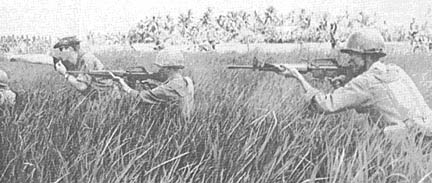 |
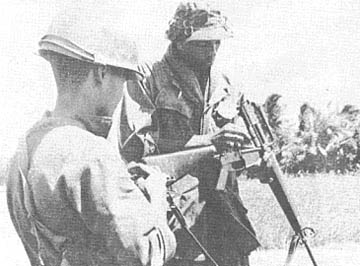 |
RIFLE CARE - Private First Class Dennis Staples of Cleveland, Ohio, shows an ARVN soldier how to clean his M-16 rifle after firing. Training in the care of the M-16 is one of the team's most important jobs. |
| "QUICK KILL" - Private First Class Dennis Staples of Cleveland, Ohio, fires a BB gun at a can thrown by Specialist 4 Crecencio Mondragon of Chicago, Ill., Staff Sergeant Milton Lilly (center) of Cleveland, Ohio, explains the "quick kill" demonstration to the class of Vietnamese soldiers. [see also The Birth of Quick Kill] |
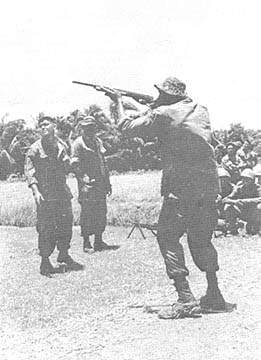 |
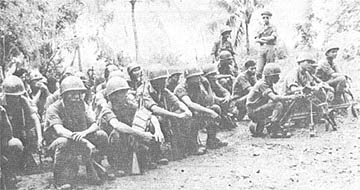 |
RAPT ATTENTION - A company of Vietnamese soldiers intently watch the instructor during the river crossing class. The soldiers bring all their weapons with them, including mortars, in case the training suddenly becomes the real thing. |
| PRACTICE MAKES PERFECT - Sergeant Gary Wills (center) of
Charleston, W. Va., watches a group of ARVN soldiers practice the "quick
kill" method of firing before moving to a live-fire range. [see also The Birth of Quick Kill] |
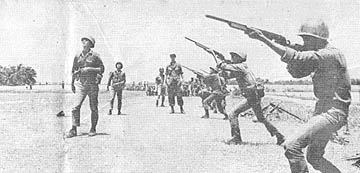 |
Page 8 TROPIC LIGHTNING NEWS September 30, 1968
25th Infantry Division In 27th Year
(Continued From Page 1)
In November the 2d Battalion, 12th Infantry, killed nearly 100 Viet
Cong in a fierce six-hour battle near Dau Tieng.
That same week, the entire 1st Brigade moved from Cu Chi to Tay
Ninh. As soon as the move was completed, the 1st and 3d Brigades began one
of the deepest penetrations of War Zone C - Operation Yellowstone. Before
the infantrymen and supporting artillery pulled out of the area in January, many
more major victories were added to the history of the 25th Division, and the
Viet Cong had lost more than 1,100 soldiers.
The Viet Cong planned to start 1968 off with a fantastic victory
over the Allied forces in War Zone C. Instead when an estimated regiment
charged Fire Support Base Burt the night of January 1, they got a rude
awakening. Six hours later when the enemy forces finally retreated, they
left 382 of their dead on the battlefield along with machineguns, AK-47 rifles,
RPG launchers and ammunition.
A week later the White Warriors of the 2d Battalion, 12th Infantry,
discovered a cache of 231 tons of rice. It was airlifted out and
distributed to needy Vietnamese in the area.
Just before the end of the month the 4th Battalion (Mechanized),
23d Infantry, found a weapons cache of more than 530 RPG rockets and booster
charges.
Then came January 31st . . . Tet.
For most of the men of the 25th Infantry Division, Tet is a word
that will long be remembered. While the Tet truce was still in effect, the Viet Cong
launched a huge, well-planned attack up and down the country. The main
thrusts were aimed at Saigon and the surrounding area - Tropic Lightning's territory.
Just hours after the first attacks started the 3d Squadron, 4th
Cavalry, raced to Saigon. With tremendous mobility and firepower they
joined forces to route the Viet Cong from the sprawling Tan Son Nhut Air Base
which was under heavy attack when the cavalrymen arrived.
Division Artillery units pounded suspected infiltration routes as
well as known VC concentrations night and day.
Infantry units were airlifted from one place to another to stop
enemy movement and to break the attacks. Tropic Lightning aviators flew
all hours of the day and night to provide aerial support and supplies.
Quiet villages like Tan Phu Trung and Hoc Mon were suddenly known
by many.
During the first 15 days following the start of the Tet offensive,
the Cav and the Wolfhounds defended the Saigon, Tan Son Nhut and Hoc Mon areas.
At times they fought in the streets, block by block.
The 3d Battalion, 22d Infantry, and 2d Battalion, 12th Infantry,
immediately came down to Cu Chi to route the enemy there and to keep Highway 1
open.
The remaining infantry and mechanized units had the job of holding
down the area usually covered by the entire Division.
Within 15 days after the first attack more than 1,000 Viet Cong
were killed by the 25th Division.
In mid-February two platoons from the 2d Battalion, 14th Infantry,
killed 137 enemy inside Tay Ninh City.
On March 18 the biggest military operation of the war to that time
began. The 25th was a key unit in Operation Quyet Thang along with two
other U.S. divisions and a number of Vietnamese units. When the operation
ended, 729 Viet Cong had been killed by the 25th.
Late in March three 25th units combined firepower near Trang Bang
for three days of fierce fighting that killed 470 Viet Cong. The area was
believed to be a staging point for another attack on Saigon.
In the last week of April, a 3d Brigade battalion was hit by a mass
assault while on Operation Toan Thang I. The enemy lost 124 in the
five-hour battle.
On May 1, President Johnson decorated two Wolfhound soldiers with
the Nation's highest medal. Captain Robert Foley and Sergeant John Baker
were both awarded the Medal of Honor for their action in a battle near Dau Tieng.
In two days in early May the Wolfhounds uncovered 1,700 RPG and
mortar rounds as well as almost eight tons of rice.
Then the 1st Battalion, 27th Infantry, and the 3d Squadron, 4th
Cavalry, combined speed and maneuverability to smash a Viet Cong attack three
miles from Dau Tieng.
May 27th, the 4th Battalion (Mechanized), 23d Infantry, along with
the Cav stopped a VC battalion that was pushing toward Saigon to join the second
VC offensive. A week later a 3d Brigade task force killed 600 Viet Cong
and NVA trying to get out of Saigon after the unsuccessful offensive.
In the first week of June, 99 VC were killed by the Tomahawks and
the 3d Battalion, 49th ARVN Regiment, 10 miles southeast of Cu Chi.
On July 4, more than 400 enemy mortars and rockets crashed into the
Dau Tieng base camp to soften it up for a ground attack. The attack was
repulsed and a sweep of the area uncovered hundreds of unused satchel charges,
weapons and rounds of ammunition.
In July the Division welcomed two new Assistant Division
Commanders. Brigadier General Carleton Preer, Jr., took over as ADC for support
and Brigadier General Glen C. Long became ADC for maneuver.
Late in July a 2d Battalion, 27th Infantry, night position was
assaulted by a large number of enemy troops following a mortar and RPG barrage.
When the battle northwest of Saigon ended, 71 Viet Cong lay dead.
On August 3 the 25th Division bade farewell to Major General F.K.
Mearns as they welcomed Major General Ellis W. Williamson as the new commanding
general.
On August 18, a week began that proved to be quite fatal for Viet
Cong elements. It started off with attacks on two fire support bases near
Tay Ninh and Dau Tieng. After repelling these attacks, action included a
fierce battle in which the 1st Battalion (Mechanized), 5th Infantry, killed 182
in 11/2 hours. Later an infantry platoon from the 2d Battalion, 27th
Infantry accounted for 55 enemy dead. The total Viet Cong killed during
the week was more than 900.
Since its last birthday, the 25th Infantry Division has killed more
than 11,000 enemy troops. Division Artillery has fired more than
one-million rounds adding up to more than 37,000 tons. At the same time,
the Division Civic Actions program has built 4,400 homes for refugees, and
MEDCAP teams have treated more than 260,000 patients.
Even with these accomplishments, the Tropic Lightning Division is
not looking back over the past 27 years, but forward to its 28th. The
accomplishments of the last year are the challenge for the next.
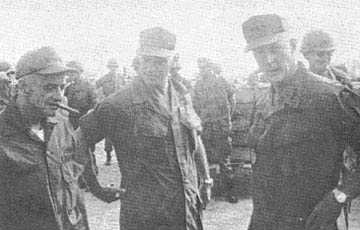 |
VIP VISIT - Admiral John S. McCain, Jr., Commander in Chief, Pacific, (left) talks with Major General Ellis W. Williamson, 25th Infantry Division Commander, (center) and Lieutenant General Walter T. Kerwin, Jr., Commanding General, II Field Force, (right) at Fire Support Base Rawlins during the Admiral's recent visit. (PHOTO BY MAJ. A.J. SULLIVAN) |
1st Bde Halts VC
(Continued From Page 1)
A disorganized ground attack was repelled by infantrymen of the 3d
Battalion, 22d Infantry, and an early morning sweep of the area revealed nine
enemy dead. Also found were: 2 RPG-7 launchers with 7 rounds and 10
boosters, 37 hand grenades, and 2 bangalore torpedoes.
Also hit with enemy fire were Fire Support Base St. Barbara, which
received 50 rounds of 82mm mortar fire; Tay Ninh base camp, which received nine
107mm rockets; and Dau Tieng base camp which was hit with less than twenty 82mm
mortar rounds.
Action during the remainder of the day was on a smaller scale as
1st Brigade elements sought to find the enemy and destroy him.
Elements of the 25th Infantry Division maintained blocking
positions to the south and east of Tay Ninh City as two battalions of Vietnamese
airborne soldiers swept through the city.
Companies A and C of the 3d Battalion, 22d Infantry, conducted a
reconnaissance-in-force to the west of Tay Ninh.
In other action, gunships of B Troop, 3d Squadron, 17th Air
Cavalry, killed two Viet Cong who were hiding under trees two miles north of Nui
Ba Den. B Troop chopper crews killed seven more NVA soldiers seven miles
northeast of Tay Ninh base camp.
Lone NVA Charges 'Hounds
2D BDE - For days men from the 25th Infantry Division's 2d
Battalion, 27th Infantry, had been searching the dense jungle area in Tay Ninh
Province and found nothing. Then suddenly out of the undergrowth came a
well-armed NVA soldier heading straight for the Wolfhounds.
The lone enemy trooper had been forced from the hedgerow when his
squad drew fire from the 1st Brigade command and control ship.
Sergeant Gale Smith, a 23 year-old Virginian reported, "the enemy
came out into the opening and headed directly towards me, I took good aim and
the first couple of shots did the job."
A later search of the area revealed the NVA soldier's body along
with an AK-47 and a compass.
| ON GUARD - A door gunner on a "command and control" helicopter keeps a close watch on the lead chopper during a 2d Battalion, 27th Infantry Wolfhound air assault. The Tropic Lightning troopers made the assault into Viet Cong infested territory northwest of Saigon. (PHOTO BY SP4 BILL CLEVENGER) | 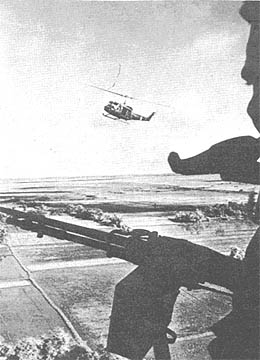 |
Thanks to
Paul Gargis, 3rd Bn., 22nd Inf. for sharing this issue,
Kirk Ramsey, 2nd Bn., 14th Inf. for creating this page.
This page last modified 8-12-2004
©2004 25th Infantry Division Association. All rights reserved.